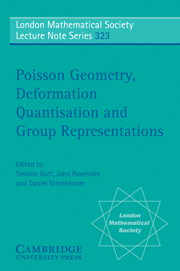Book contents
- Frontmatter
- Contents
- Preface
- Part One Poisson geometry and morita equivalence
- 1 Introduction
- 2 Poisson geometry and some generalizations
- 3 Algebraic Morita equivalence
- 4 Geometric Morita equivalence
- 5 Geometric representation equivalence
- Bibliography
- Part Two Formality and star products
- Part Three Lie groupoids, sheaves and cohomology
- Part Four Geometric methods in representation theory
- Part Five Deformation theory: a powerful tool in physics modelling
- Index
1 - Introduction
Published online by Cambridge University Press: 04 August 2010
- Frontmatter
- Contents
- Preface
- Part One Poisson geometry and morita equivalence
- 1 Introduction
- 2 Poisson geometry and some generalizations
- 3 Algebraic Morita equivalence
- 4 Geometric Morita equivalence
- 5 Geometric representation equivalence
- Bibliography
- Part Two Formality and star products
- Part Three Lie groupoids, sheaves and cohomology
- Part Four Geometric methods in representation theory
- Part Five Deformation theory: a powerful tool in physics modelling
- Index
Summary
Poisson geometry is a “transitional” subject between noncommutative algebra and differential geometry (which could be seen as the study of a very special class of commutative algebras). The physical counterpart to this transition is the correspondence principle linking quantum to classical mechanics.
The main purpose of these notes is to present an aspect of Poisson geometry which is inherited from the noncommutative side: the notion of Morita equivalence, including the “self-equivalences” known as Picard groups.
In algebra, the importance of Morita equivalence lies in the fact that Morita equivalent algebras have, by definition, equivalent categories of modules. From this it follows that many other invariants, such as cohomology and deformation theory, are shared by all Morita equivalent algebras. In addition, one can sometimes understand the representation theory of a given algebra by analyzing that of a simpler representative of its Morita equivalence class. In Poisson geometry, the role of “modules” is played by Poisson maps from symplectic manifolds to a given Poisson manifold. The simplest such maps are the inclusions of symplectic leaves, and indeed the structure of the leaf space is a Morita invariant. (We will see that this leaf space sometimes has a more rigid structure than one might expect.)
The main theorem of algebraic Morita theory is that Morita equivalences are implemented by bimodules. The same thing turns out to be true in Poisson geometry, with the proper geometric definition of “bimodule”.
- Type
- Chapter
- Information
- Publisher: Cambridge University PressPrint publication year: 2005

